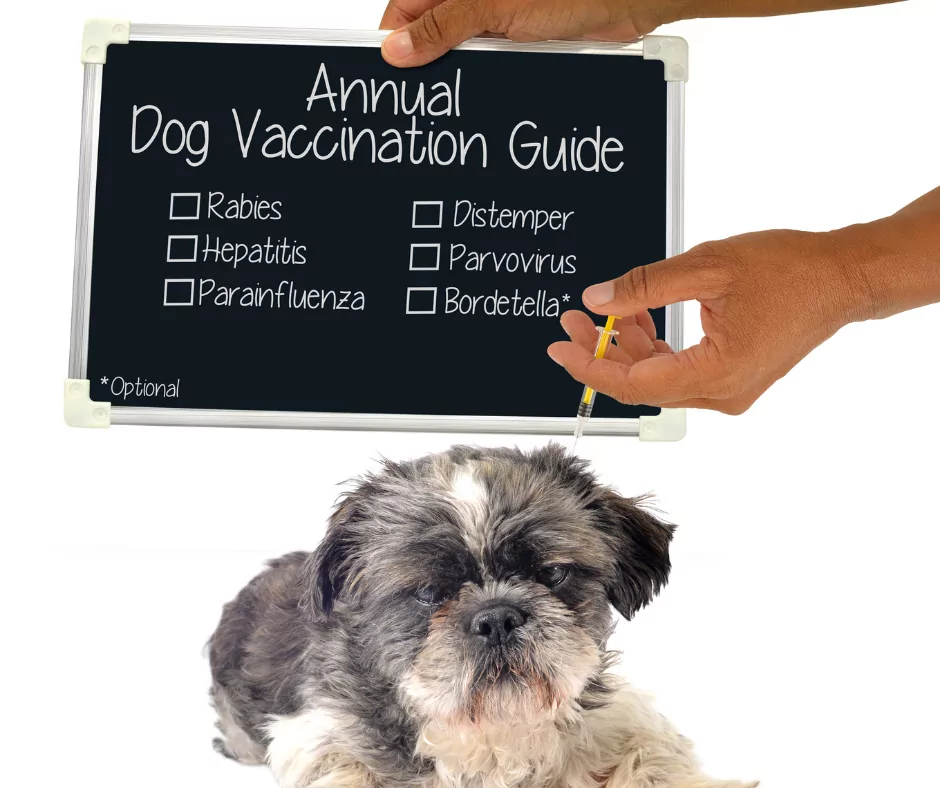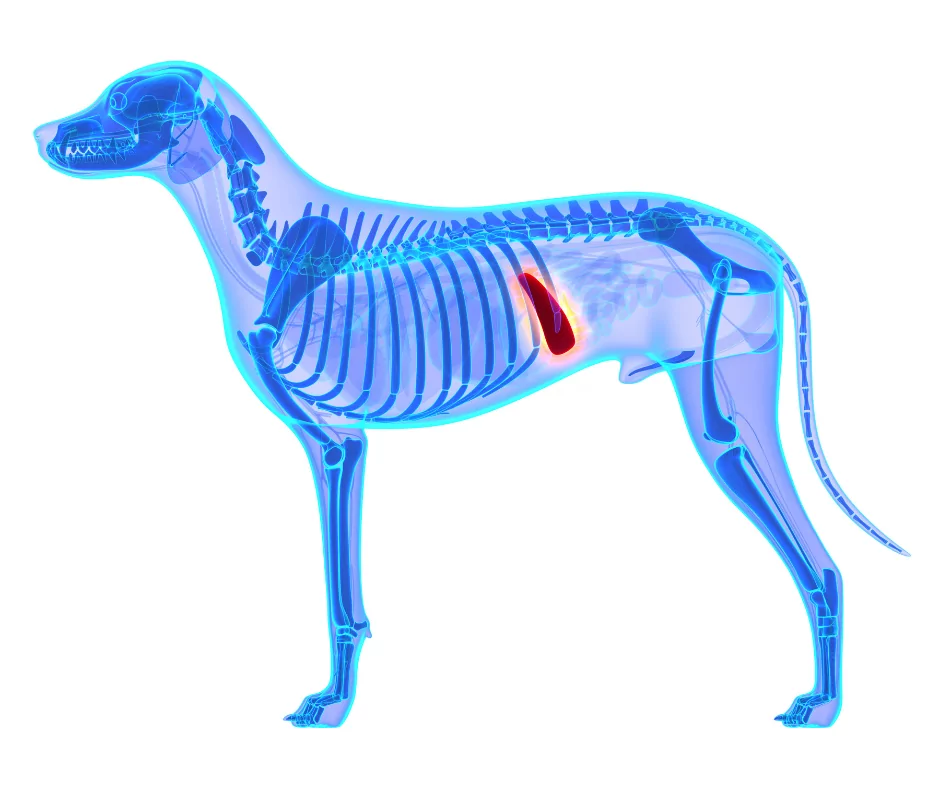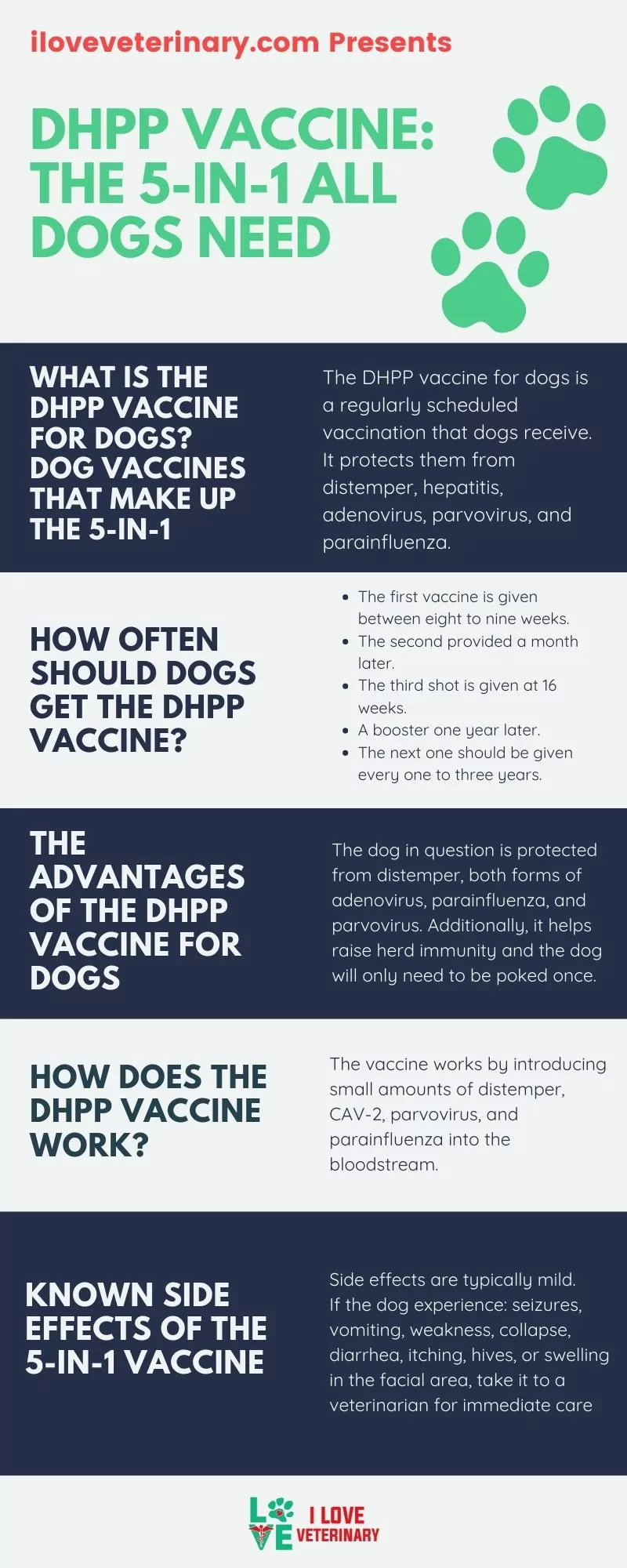One of the regularly suggested injections for your furry friend is the DHPP vaccine. You love your dog, and you would do anything to keep them healthy and safe. This includes keeping them on a regular vaccine schedule.
This article will break down the particulars of the DHPP vaccine so you know exactly what it covers when it should be given, how it works, and any side effects it may bring about.
What is The DHPP Vaccine for Dogs?
The DHPP vaccine for dogs is a regularly scheduled vaccination that dogs receive. It protects them from distemper, hepatitis, adenovirus, parvovirus, and parainfluenza. Distemper, hepatitis, and parvovirus dog shots are under the category of core vaccinations. Despite its age or living situation, every dog should be given core vaccinations per the veterinarian recommended schedule.

How Often Should Dogs Get the DHPP Vaccine?
The DHPP vaccine is given routinely as part of the puppy shot schedule. The first vaccine is given between eight to nine weeks, with the second provided a month later. A third shot is given at 16 weeks, and then a booster one year later.
After that, it becomes a part of regular dog vaccinations and, depending on the brand of the vaccine and country recommendations, it should be given every one to three years.
Dog Vaccines That Make Up the 5-in-1
The vaccines that make up the 5-in-1 vaccine are distemper, hepatitis, kennel cough (also called CAV-2), parainfluenza, and parvovirus.
Distemper
Distemper is contagious and often fatal. It impacts the skin, gastrointestinal system, respiratory system, and neurological system. There is no cure for distemper, which is spread through direct contact.
Symptoms of distemper include nose and ocular discharge, vomiting, and diarrhea. Dogs with distemper often have hardening of their paw pads and coughing, seizures, and a high fever. During the late stages of the disease, a head tilt is common: circling, paralysis (both partial or full), nystagmus, and increased drooling while making a chewing motion.
Dogs put on supportive care and who make it through the infection are often stricken with permanent neurological disorders. Distemper is spread one of three ways: from contact with an infected animal, through the placenta, or airborne particles. It impacts other species of animals as well, particularly common wildlife like skunks, raccoons, and squirrels.
Hepatitis
Hepatitis is one of the adenoviruses from which DHPP protects. Specifically, it is called CAV-1. With hepatitis, the dog’s spleen, liver, kidneys, and blood vessel linings are targeted. It is contracted through the feces and urine of an already infected dog, and severe cases may result in death in as little as a few hours.

Dogs with hepatitis show jaundice in the whites of their eyes and the color of their gums. They appear lethargic, may have unexplained bruises, exhibit swelling of the lymph nodes, and anorexia. They also seem uncomfortable in their abdominal area and may experience vomiting and diarrhea. Their ability to clot is also impacted.
The first sign of hepatitis is a fever over 104 degrees Fahrenheit. If the fever persists, their tonsils may appear enlarged. Their eyes will look inflamed. The dog may begin to bleed spontaneously, and bleeding taking place in the brain may cause paralysis.
There is no cure for chronic canine hepatitis, but the dog can be placed on supportive care. If a dog makes it through the initial flare, it may still suffer damage to its liver, eyes, and kidneys.
Kennel Cough
Also known as CAV-2, this is the second form of adenovirus. CAV-2 is spread through direct contact with another dog with the disease, which is actively coughing and sneezing. Dogs typically spike a fever, have nasal discharge, and are stricken with a very dry cough. CAV-2 is common, highly contagious, and curable.
Several factors make dogs more susceptible to CAV-2. These include cold temperatures, being exposed to cigarette smoke or dust, and stress caused by travel. Being exposed to crowded, unventilated environments also makes it easier for a dog to catch CAV-2.
While many dogs who contract CAV-2 heal within three weeks, occasionally, the symptoms extend for a few more weeks. If a dog with CAV-2 stops eating, seems listless or begins to breathe rapidly, contact a veterinarian immediately. These are signs that CAV-2 has moved deeper into the lungs and become pneumonia.
Parainfluenza
Parainfluenza has some of the same attributes as CAV-2. It causes respiratory distress and coughing and, like CAV-2, is very contagious. It is contracted through airborne particles and is very treatable. Many dogs do not even need treatment and recover in two to three weeks on their own.
Dogs with parainfluenza have a dry cough for a week or more. This cough may be accompanied by nasal discharge. In some cases, parainfluenza suppresses part of the immune system and leaves the dog vulnerable for co-infections, be it bacterial or viral. Immunosuppressed dogs and puppies have a greater risk of developing pneumonia if not treated quickly and appropriately.
While the two may sound alike, it is essential to remember that parainfluenza and canine influenza are two different ailments. In order to be vaccinated against the dog flu, a separate vaccination must be given.
Parvovirus
Parvovirus is most common in dogs under six months, so the parvovirus vaccination must be a part of the regimen of puppy shots. While it is most common in puppies, it can infect dogs of any age. It is highly contagious and spread through feces and objects contaminated by dogs with parvovirus.
Unfortunately, dogs can begin spreading parvovirus before the first symptom even arises, as they start to shed the virus around day four or five after initial contact. Dogs lucky enough to recover continue shedding the virus for another ten days after their final symptom. The virus remains potent for up to one month indoors and, under the right conditions, it can survive for months to a year outside.
Parvovirus invades the gastrointestinal tract and the immune system, leaving the infected dog open to co-infections. Dogs with parvovirus have excessive vomiting and bloody diarrhea, because of which they lose all sources of protein and become dehydrated. They are also feverish, lethargic, and stop eating. Without aggressive treatment that addresses fluid and nutrient replacement, a dog with parvovirus will die.
Several breeds are more susceptible to parvovirus than others. These include the following:
- Labrador Retrievers
- Rottweilers
- German Shepards
- Doberman Pinschers
- English Springer Spaniels, and

- American Staffordshire Terriers
The Advantages of The DHPP Vaccine for Dogs
The advantages of the vaccine greatly outweigh any risk. For one, the dog in question is protected from distemper, both forms of adenovirus, parainfluenza, and parvovirus. Additionally, it helps raise herd immunity, decreasing the risk of catching or spreading any diseases mentioned earlier throughout the entire dog population.
Another advantage of the 5-in-1 shot is that the dog will only need to be poked once. It can also be combined with other shots, such as leptospirosis, furthering the protection given to the dog.
The 5-in-1 shot also has the backing of many research studies. This ensures its safety.
The Desired Frequency of The 5-in-1 Shot
Puppies are given a dose of the 5-in-1 shot every two to four weeks until they are 16 weeks old. For dogs over 16 weeks that have yet to be vaccinated, one to two doses are given several weeks apart.
Dogs require regular boosters after their initial loading doses. The first booster is given 12 months after the end of the loading doses. The frequency of the 5-in-1 shot depends on both country recommendations and the brand used by the veterinarian. While some are due once a year, other brands can be given every three years.
How Does The DHPP Vaccine Work?
The vaccine works by introducing small amounts of distemper, CAV-2, parvovirus, and parainfluenza into the bloodstream.
These amounts are modified to not create an infection in the dog’s body; they will simply be introduced to the immune system to produce an immune response. The immune system familiarizes itself with the portions of the virus.
This way, if the dog encounters another dog with one of these diseases and is infected, the immune system knows exactly what to do to fight it off.
Known Side Effects of The 5-in-1 Vaccine
Side effects are not uncommon when the vaccine is administered. However, they are typically mild; the dog may experience pain or swelling at the injection site and a bit of lethargy.
Dogs that experience any of the following should be taken to a veterinarian for immediate care: seizures, vomiting, weakness, collapse, diarrhea, itching, hives, or swelling in the facial area.

Vaccination of dogs is critical in eliminating the threat of severe diseases, especially distemper, hepatitis, CAV-2, parainfluenza, and parvovirus, most of which have no cure and require aggressive supportive care in order for the dog to survive.
The 5-in-1 shot offers the benefit of protection from each of those diseases in one shot. When given regularly, not only is the individual dog protected, the individual dog is, but the entire species is protected as herd immunity grows.

